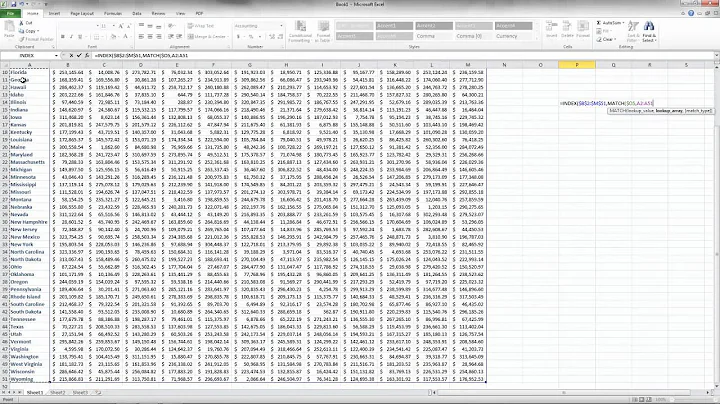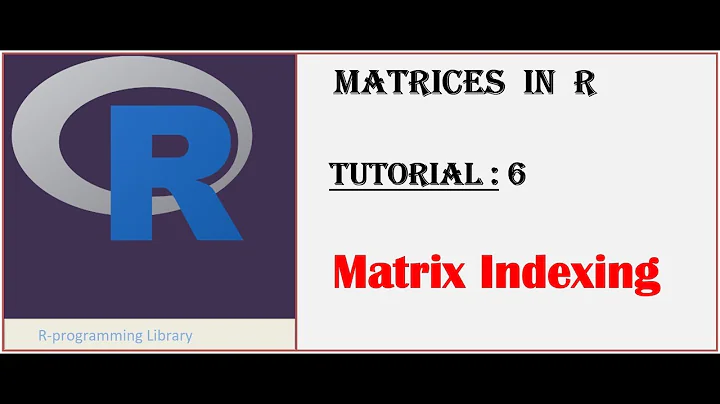Index values from a matrix using row, col indices
Solution 1
Almost. Needs to be offered to "[" as a two column matrix:
dat$matval <- mat[ cbind(dat$I, dat$J) ] # should do it.
There is a caveat: Although this also works for dataframes, they are first coerced to matrix-class and if any are non-numeric, the entire matrix becomes the "lowest denominator" class.
Solution 2
Using a matrix to index as DWin suggests is of course much cleaner, but for some strange reason doing it manually using 1-D indices is actually slightly faster:
# Huge sample data
mat <- matrix(sin(1:1e7), ncol=1000)
dat <- data.frame(I=sample.int(nrow(mat), 1e7, rep=T),
J=sample.int(ncol(mat), 1e7, rep=T))
system.time( x <- mat[cbind(dat$I, dat$J)] ) # 0.51 seconds
system.time( mat[dat$I + (dat$J-1L)*nrow(mat)] ) # 0.44 seconds
The dat$I + (dat$J-1L)*nrow(m) part turns the 2-D indices into 1-D ones. The 1L is the way to specify an integer instead of a double value. This avoids some coercions.
...I also tried gsk3's apply-based solution. It's almost 500x slower though:
system.time( apply( dat, 1, function(x,mat) mat[ x[1], x[2] ], mat=mat ) ) # 212
Solution 3
Here's a one-liner using apply's row-based operations
> dat <- as.data.frame(matrix(rep(seq(4),4),ncol=2))
> colnames(dat) <- c('I','J')
> dat
I J
1 1 1
2 2 2
3 3 3
4 4 4
5 1 1
6 2 2
7 3 3
8 4 4
> mat <- matrix(seq(16),ncol=4)
> mat
[,1] [,2] [,3] [,4]
[1,] 1 5 9 13
[2,] 2 6 10 14
[3,] 3 7 11 15
[4,] 4 8 12 16
> dat$K <- apply( dat, 1, function(x,mat) mat[ x[1], x[2] ], mat=mat )
> dat
I J K
1 1 1 1
2 2 2 6
3 3 3 11
4 4 4 16
5 1 1 1
6 2 2 6
7 3 3 11
8 4 4 16
Related videos on Youtube
Mike T
Hydrogeologist, numerical modeller and GIS professional. My main programming languages that I use are Python, R, SQL. I dabble with Fortran and C/C++/C# on occasions. Thanks to anyone that has helped me!
Updated on September 06, 2020Comments
-
Mike T over 3 years
I have a 2D matrix
matwith 500 rows × 335 columns, and a data.framedatwith 120425 rows. The data.framedathas two columnsIandJ, which are integers to index the row, column frommat. I would like to add the values frommatto the rows ofdat.Here is my conceptual fail:
> dat$matval <- mat[dat$I, dat$J] Error: cannot allocate vector of length 1617278737(I am using R 2.13.1 on Win32). Digging a bit deeper, I see that I'm misusing matrix indexing, as it appears that I'm only getting a sub-matrix of
mat, and not a single-dimension array of values as I expected, i.e.:> str(mat[dat$I[1:100], dat$J[1:100]]) int [1:100, 1:100] 20 1 1 1 20 1 1 1 1 1 ...I was expecting something like
int [1:100] 20 1 1 1 20 1 1 1 1 1 .... What is the correct way to index a 2D matrix using indices of row, column to get the values?-
Ari B. Friedman almost 13 years+1 for an interesting question (which begs another question: why isn't there an option to change the behavior to something a little more like this when passing the
[operator N vectors for an N-dimensional matrix?) -
 joran almost 13 yearsNice question - I edited it very slightly to fix what I think is a typo (
joran almost 13 yearsNice question - I edited it very slightly to fix what I think is a typo (datItodat$I). If this isn't what you meant feel free to undo...
-
-
Ari B. Friedman almost 13 years+1 for finding the way that R clearly intended to do things ;-)
-
 joran almost 13 yearsSo if
joran almost 13 yearsSo ifIandJare the only columns, is justmat[dat]sufficient? Or do you need to coerce to a matrix? -
 joran almost 13 yearsSeems coercion is necessary since the data frame is really a list. So you could also do
joran almost 13 yearsSeems coercion is necessary since the data frame is really a list. So you could also doas.matrix(dat). -
 IRTFM almost 13 years@gsk3: Look at the Arguments section for ?"[" under "..." . When an array or matrix is being addressed, the matrix must have the same number of columns as the addressed object has dimensions. There are also some examples on that help page.
IRTFM almost 13 years@gsk3: Look at the Arguments section for ?"[" under "..." . When an array or matrix is being addressed, the matrix must have the same number of columns as the addressed object has dimensions. There are also some examples on that help page. -
Chase almost 13 yearsWhat happens if the data.frame contains index values for I and J that are outside the bounds of the matrix? I'm pretty sure it will fail...I think @Tommy's answer will return NAs for that scenario. Just something to keep in mind...
-
Johan Karlsson about 9 yearsSome comments would be nice and make the answer be more "attractive".
-
 Skizo-ozᴉʞS about 9 yearsYou can not answer only a bunch of code... Come on... explain a little bit your answer :)
Skizo-ozᴉʞS about 9 yearsYou can not answer only a bunch of code... Come on... explain a little bit your answer :) -
 Heisenberg almost 8 yearsThis indexing method is rather obscure, not covered in "Intro to R" tutorials. I got curious and read the docs, which does cover it
Heisenberg almost 8 yearsThis indexing method is rather obscure, not covered in "Intro to R" tutorials. I got curious and read the docs, which does cover it






